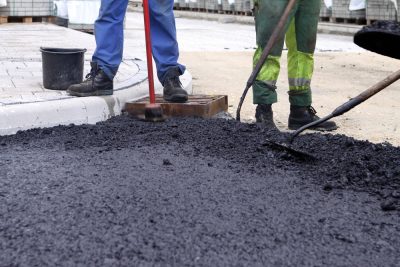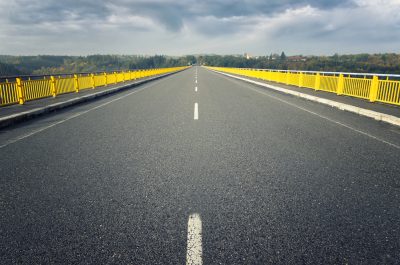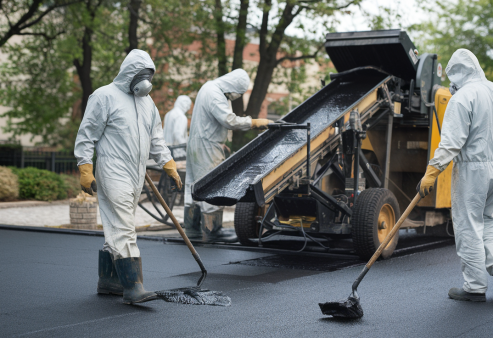How to Choose Between Hot Mix and Cold Mix Asphalt
Table of Contents 1. Key Takeaways 2. Understanding Asphalt Types What is Hot Mix Asphalt? What is Cold Mix Asphalt? Key Differences in Composition and Application 3. Performance ...

Experienced Professionals Delivering High-Quality Asphalt Services
Residential License # 890459
Commercial License # 3667

Call Us Today!
Proper drainage in asphalt is necessary for avoiding long-term damage caused by water standing on the surface. Standing water leads to cracks, potholes, and structural damage to the asphalt. Graded surfaces and brilliantly placed drains are practices that preserve the asphalt’s integrity and lifespan.
Let our team from TurnKey Asphalt educate you on how appropriate drainage could hold your investment and ensure long-lasting durability. Contact us today to see how we can help, and let’s make your driveway or parking area built to last.

Effective asphalt drainage is crucial for durable pavements. Poor water management leads to faster deterioration, costly repairs, and reduced lifespan.
Water and drainage lessen the damaging effect of standing water on the asphalt. The infiltration of water weakens the base underneath the pavement, while freezing and thawing can cause detrimental cracks. Adequate drainage will considerably minimize such occurrences and help maintain the structural integrity even during tough weather conditions.
Well-drained asphalt may last 20 to 30 years or more, even though badly drained surfaces may last only a few years. It means less cracking or potholes from excessive aging; good drainage protects the surface for over two decades with minor resurfacing requirements.
For an above-par drainage system from the very start, future repairs can become much less hectic and easier on the wallet. Maintenance such as clearing drains is one activity that avoids costs in excess of pothole patching to full-depth reconstruction; therefore, effective drainage becomes a good economic option for increased asphalt life.
Effective asphalt drainage is essential for maintaining pavement performance. Water is a major threat to asphalt, leading to cracks, potholes, and foundation damage. Learn the key principles for effective drainage design.
Grading and sloping are prerequisites to drainage systems. A 1%-2% slope will keep the water from accumulating, thus preventing major damage. Surface grading acts in conjunction with subsurface systems, such as perforated pipes or French drains, to direct water away from the asphalt base.
Material selection is vital for good drainage. High-quality asphalt mixtures with water-resistant binders prevent infiltration. Furthermore, the adoption of open-graded asphalt or gravel beneath enhances drainage, which allows the water to percolate through under the surface and improves the durability of the pavement.
Localized drainage management and erosion concerns in low-traffic areas like parking lots can be addressed using permeable pavements. Permeable pavements reduce runoff, evaporation of moisture, and protect the infrastructure below.
Local climates should be considered when drainage is designed, mainly during heavy rains and freezing temperatures. Areas with high rainfall need efficient drainage options, like steep slopes or advanced subsurface systems, to avoid water effects.
Effective drainage is essential for the safety and longevity of asphalt pavements. Managing water flow helps prevent issues like cracking and rotting wooden railway ties over time. Here’s how proper drainage reduces risks and supports durable asphalt solutions:
Water infiltration poses a significant danger to asphalt. Seeping in through cracks, water erodes the binding agents, which then leads to softening and inadequacy of asphalt. Proper drainage ensures water runs off instead of pooling, and even a slope of 1-2% will assist in directing water away.
The subsurface drainage systems, such as perforated pipes, help to prevent erosion under the asphalt. They check the erosion of the soil foundation by preventing the standing water from eroding stability by forming hidden voids within. With proper drainage, a parking lot can bear the loads of vehicles safely for a long time.
If the drainage is inadequate, water can cause a combination of uneven load distribution that weakens the asphalt over time in high-stress areas. Controlling the water-induced pressures helps in reducing early cracking and sags.
Areas with pooling water are prone to potholes and rutting in freeze-thaw cycles. A good drainage design will help avert these costly issues so that surfaces remain safe and functional.
The presence of standing water creates a higher risk for hydroplaning. This jeopardizes the lives of drivers. The engineered drainage systems in the asphalt combine to make for a safer world-from the driveway to major highways.

Effective drainage is essential for the durability of asphalt surfaces. Tailoring drainage methods to specific climates can significantly enhance asphalt’s lifespan, reduce maintenance costs, and improve overall design longevity.
Freeze-thaw cycles in cold climate areas can cause the development of cracks and potholes. A suitable slope of 1-2% should be proposed away from the facility to drain water without obstructing vehicular traffic. Excess moisture would be removed from the structures by subsurface drainage, such as perforated pipes and French drains. Timely sealing of the cracks, as well as the smaller use of de-icing materials, would also prevent infiltration of water.
In these areas experiencing concentrated rains and humidity, standing water erodes asphalt and causes premature cracking. Proper grading and drainage enable quick runoff of water. Subsurface systems are an effective means; permeable asphalts would assist in controlling runoff over larger areas.
Even during dry spells, quick drainage must be ensured to prevent damage due to sudden downpours. Quick drainage is facilitated through a 1-2% slope, thereby reducing stress on asphalt. Regular cross-grading and clearing the accumulated debris from drainage systems are also essential during storm periods against erosion.
Effective asphalt drainage systems are essential for prolonging the life of paved areas. When water is allowed to flow freely, it significantly increases wear and tear. Our solutions provide long-lasting performance and cost savings for clients.
Proper drainage systems evacuate water from asphalt surfaces before it seeps underneath, which is crucially damaging for the pavement, causing cracking, potholes, and surface damage. Water can also erode the subbase if drainage functions poorly, leading to premature structural failure. Adequate drainage prolongs an asphalt surface thousands of times more, maybe over 20 years, making it a sound investment for every homeowner and commercial business.
Standing water on asphalt presents severe hazards for motorists and pedestrians, one being hydroplaning. Cycloidal freezing in winter can create wicked ice patches. But redirecting the water safely will keep one safer on the road.
Impact: Effective drainage systems go a long way in supporting environmental stewardship by managing stormwater runoff and curtailing erosion and pollution threats to community water supplies. Nature-based solutions like bioswales and permeable pavements go a long way in sustainability.
If drainage systems are inadequately installed, their usage contributes to perhaps 20 percent of asphalt pavement failure. If an adequate drainage system is adopted, then it automatically eliminates repair costs and maintenance, thus securing your pavement and financial interests.
Drainage on asphalt is necessary for the durability and performance of surfaces. Accumulated water causes cracks and potholes that result in very expensive repairs. Good drainage expels water from the surface promptly, thus protecting the foundation and eliminating hazards such as pooling and ice.
We design a drainage system for specific climatic and site requirements for the long-term protection of your asphalt. Proper drainage means less repair, lower maintenance costs, and more durability. Contact us at TurnKey Asphalt today for your project, and we will develop an individualized drainage solution for you!

Table of Contents 1. Key Takeaways 2. Understanding Asphalt Types What is Hot Mix Asphalt? What is Cold Mix Asphalt? Key Differences in Composition and Application 3. Performance ...


The economical and intelligent choice for paving projects is recycled asphalt. With TurnKey Asphalt, homeowners and businesses can now enjoy long-lasting surfaces that are less expensive and more e...


Asphalt, a vital part of our roads and driveways, faces constant challenges from the weather. From the intense heat that softens it to the freezing cold that causes cracks, and the ongoing freeze-t...


Table of Contents 1. Key Takeaways 2. Recognizing Early Signs of Asphalt Wear a. Identifying Small Cracks and Splits b. Spotting Surface Discoloration and Fading c. Detecting Water P...


Keeping your asphalt driveway in excellent condition throughout the year doesn’t have to be overwhelming. With simple steps and a proactive approach, you can protect your driveway from wear caused ...


Table of Contents: 1. Key Takeaways 2. Asphalt or Gravel: Key Differences a. Composition and Texture b. Maintenance Requirements c. Weather Performance 3. Understanding Asphalt Pa...
